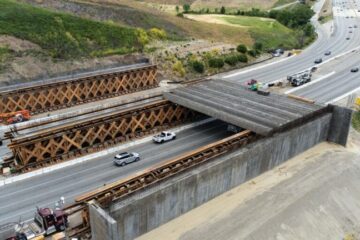EPA fights Moab Nuclear Waste Dump Near River
Energy Department’s proposal to leave a radioactive pile near the Colorado River in Utah is seen as a threat to drinking water.
Source of this article – Los Angeles Times, March 5, 2005.
By JANET WILSON, Times Staff Writer
The U.S. Environmental Protection Agency has told the Department of Energy that its proposal to leave 12 million tons of radioactive waste next to the Colorado River near Moab, Utah, is “environmentally unsatisfactory” and a potential prolonged risk to public health.
The EPA comments are part of mounting opposition from Western governors, including California’s Arnold Schwarzenegger, bipartisan members of Congress, water agencies and others who say leaving the waste pile from an abandoned uranium mill would threaten drinking water for 25 million people downstream, including Southern California residents.

RADIOACTIVE WASTE: Layers of uranium tailings from an abandoned mine have sat for years near the Colorado River in Utah.
“We were delighted to see the EPA express the position that it was environmentally unsatisfactory and infeasible” to leave the waste on site, said Brad Hiltscher, a Washington, D.C., staff lobbyist for the Los Angeles-based Metropolitan Water District, which provides water to 18 million customers in six Southern California counties..
“There are 12 million tons of material sitting just a couple hundred feet from the Colorado River, which is a known volatile body of water,” Hlltscher said. “No water agency is going to want to deliver radioactive water to its customers…. As of today there is no known treatment for removing radioactive waste from water. Period.”
The Department of Energy proposal, which would cap the waste on-site — near several popular national parks — is one of four approaches under consideration by the agency. Others include shipping the uranium tailings and other contaminants off-site by rail or truck to arid, rocky sites to the north, or sucking them out via a giant pipe to a site to the south.
While EPA staff had some concerns about transporting the waste, they gave the lowest possible rating to capping it and leaving it next to the flood-prone, meandering river.
“The basis for our environmental unsatisfactory rating … is the potential for prolonged environmental and public health risk that could result from the continued release of toxic contaminants to ground and surface waters,” the staff wrote in comments signed by Robert E. Roberts, EPA’s regional administrator in Denver.
Giving such tin adverse rating to a proposed federal project is “fairly rare,” said Larry Svoboda, EPA’s director of National Environmental Policy Act review for the region. In this case it required approval by then-deputy administrator Stephen L. Johnson, who was nominated Friday by President Bush to head the agency.
The EPA report is one of more than 1,400 sets of comments sparked in large part by the Department of Energy’s decision not to make moving the waste the preferred option in a draft environmental impact statement for the site.
Don Metzler, the department’s on-site project manager, said it was decided several years ago that there would be no preferred option initially, precisely so that a wide range of comments could be gathered.
Metzler said he was not surprised by the reaction, the bulk of which favors moving the waste away from the river.
“It’s an important subject. The Colorado River is the life-blood of the southwest,” he said. “The fact is, what’s happened is what the decision makers at DOE wanted…. They wanted to get the subject out there and have people look at the material.”
While critics point to studies showing the flood-prone river might be migrating toward the site, Metzler said other studies have shown that the river might be moving away from it. He said it would be cheaper to cap the material in place, with projected costs of $166 million. To move it would cost between $400 million and $500 million, he said.
But after years of negotiation, most officials had assumed the unanimous choice was to move the enormous, leaking, gooey mound elsewhere.
 “At this juncture in the process, after many years of technical review and study … we want to make it clear that any remediation other than an off-site option is unacceptable,” wrote outgoing Utah Gov. Olene Walker on Dec. 29, on behalf of himself and four other governors, including Schwarzenegger.
“At this juncture in the process, after many years of technical review and study … we want to make it clear that any remediation other than an off-site option is unacceptable,” wrote outgoing Utah Gov. Olene Walker on Dec. 29, on behalf of himself and four other governors, including Schwarzenegger.
In the last month, members of Congress, including Sen. Orrin G. Hatch (R-Utah) and California Reps. David Dreier (R-San Dimas), Grace F. Napolitano (D-Norwalk) and Lucille Roybal-Allard (D-East Los Angeles), have written to the new secretary of energy, Samuel Bodman, or his staff expressing strong opposition to leaving the waste in place.
Bodman, who was sworn in last month, is “aware of the issues involving the Moab site,” spokesman Joe Davis said, and might end up making make the decision himself on what should be done.
But although that decision could come as soon as March 18, it probably won’t be made until summer, Davis said.
“We’ll be taking all the comments into account and making the decision that’s in the best interest of everyone,” Davis said. “That’s down the road sometime this summer.”
Work on the site is not expected to begin until 2007, no matter which option is approved, and could take until 2012 to complete.
Up to 15,000 gallons of ammonia and other pollutants are leaching into the river daily but are being successfully treated, Metzler said. He added that only trace amounts of radioactive material is getting into the river and is quickly diluted.
It has been a wet winter in Utah, and the EPA’s Svoboda said there is a low probability but a real risk that if a major flood were to occur, it could trigger a “catastrophic kind of failure” in which the bulk of the material would wash into the river.
“We don’t believe there’s a huge reason to be alarmed … but it remains a possibility,” Svoboda said.


